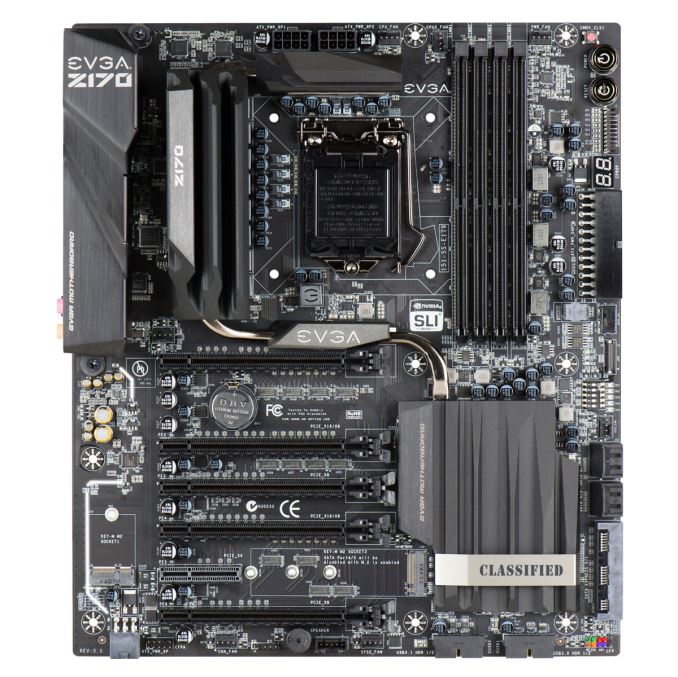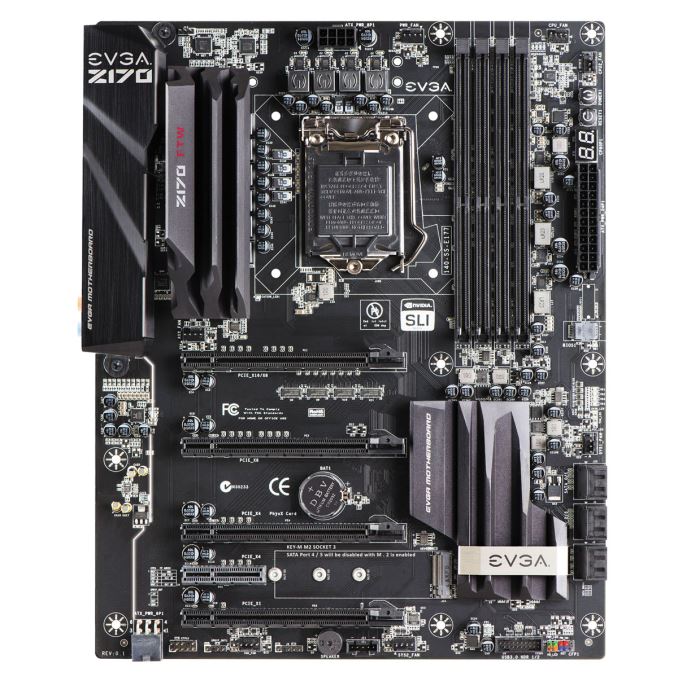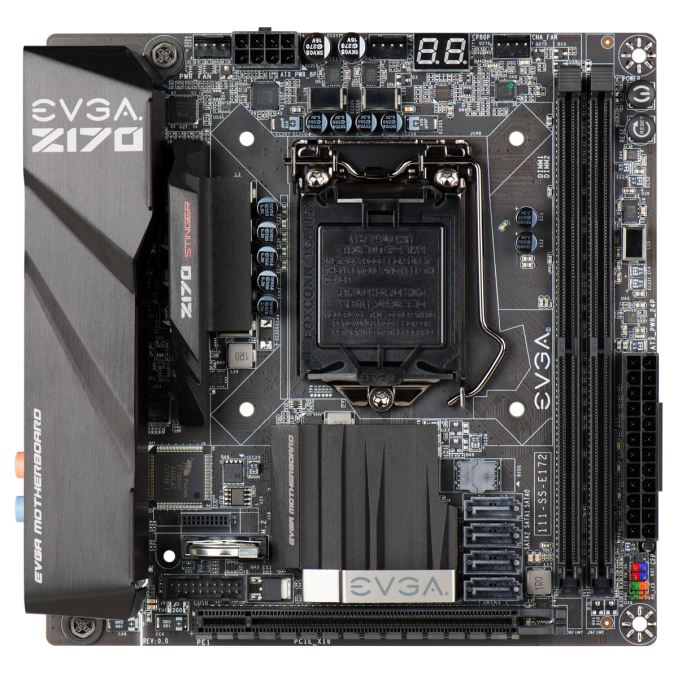Intel Skylake Z170 Motherboards: A Quick Look at 55+ New Products
by Ian Cutress on August 5, 2015 7:59 AM ESTEVGA Z170
Over the past few generations of EVGA motherboards, one of the goals has been to emulate the success they achieved during the X58 motherboard era. At that time, the motherboards were highly praised for their overclocking prowess for what was (and still is) a relatively small motherboard manufacturer. EVGA’s historic strengths lie in their legions of fans and a typical expectation that in most of their big markets, they will field the warranty issues rather than the retailer. Z170, like the others, brings on the EVGA wind in the three regular segments.
EVGA Z170 Classified
Aimed at the pure high end, the EVGA Classified might be the most expensive Z170 board on the market. Here they have used a single PLX 8747 chip under that middle heatsink to provide x8/x8/x8/x8 bandwidth to the PCIe slots. Using a PLX 8747 chip on a mid-range motherboard is not new, it was all the rage back in Z77, but what makes it different here is that the company that manufactures the chip has changed hands and now focuses on the enterprise market. As a result, the costs of such a chip are seemingly doubled overnight, making it an unenticing prospect for the consumer market. Nonetheless, EVGA is aiming for an overclocking motherboard with Quad-SLI support and here it is.
Alongside the extensive heatsink configuration to aid both the power delivery and that PLX chip, EVGA equips the board with dual network controllers (I219-V and I210-AT), a Creative Sound Core3D audio solution, two USB 3.1-A ports on the rear panel, an M.2 slot running in PCIe 3.0 x4 mode, seven 4-pin PWM fan headers, triple BIOS support, EZ voltage read points and the onboard readout will output the temperature when in the operating system.
EVGA Z170 FTW
The FTW follows a similar design pattern to the classified in terms of hardware layout, but reduces it all down into a more cost effective market. As a result the PLX chip is gone, the power delivery heatsink arrangement is reduced, a number of the OC features are lifted off and other connectivity is reduced. The single network port is an Intel I219-V, there is no USB 3.1 and we have the base six SATA ports from the chipset. We still keep the M.2 based off of the PCIe 3.0 x4 bandwidth, but the PCIe slots only support up to x8/x4/x4 with the final slot being an x1. This seems a little odd, given how many PICe lanes the chipset can use.
EVGA Z170 Stinger
The Stinger is the mini-ITX solution, keeping the line alive after several generations. Taking on board previous comments, the power connectors are now on the outside of the DRAM slots or at the top of the motherboard, along with the important front panel connectors. There seems to be enough space around the CPU slot for larger air coolers, although the SATA connector placement will be a nightmare when locking cables and large PCIe cards are used. EVGA does list the Stinger as having a 10-layer PCB, which might make it one of the mini-ITX motherboards with the most layers, although this just makes the design of the board easier and pushes up cost. Similar to the FTW, we don’t get USB 3.1 on this model with only an Intel I219-V network port and Realtek audio.













85 Comments
View All Comments
mrlithium - Friday, August 7, 2015 - link
I was interested until i read " 2 SATA3" <- not gonna cut it buddy.Diagrafeas - Friday, October 9, 2015 - link
Addition...2 SATA Express (shared with 2 m.2 which are shared with 2 PCIE x16(x4 electrical)) and obviously 4 more SATA Ports.
So you could use 2x 1m.2/or 1PCIEx4/or 1SATA Express/or 2 SATA at time.
Etern205 - Wednesday, August 5, 2015 - link
Anyone notice some of those boards have extra pins on their socket.Eidigean - Wednesday, August 5, 2015 - link
The most appealing of all of these is actually the ASUS Z170-WS. No SATA-Express, 8x8x8x8 PCIe, 2 M.2 slots in RAID, a dedicated U.2 slot for a larger external drive, dual NICs, (hopefully) an Alpine Ridge USB 3.1 solution, and no Molex connector for PCIe power; instead a 3x2 12v header.Gigaplex - Wednesday, August 5, 2015 - link
I don't think the Asus has Alpine Ridge. The article mentioned Gigabyte has an exclusive right now.mrlithium - Friday, August 7, 2015 - link
i watched a review on Asus's youtube channel PCDIY where JJ said that I think the Z170-Deluxe would support thunderbolt with the addon card, which the board has to be designed for, so they must have decided that making people buy the add-on card would be a better optionN_rman - Friday, August 7, 2015 - link
Definitely the most appealing, i agree. The only one that's even close is the Asrock 7+, with 3 32gb/s M.2 ports.Deders - Wednesday, August 5, 2015 - link
Any news as to weather Kaby Lake will be supported on these sockets? Trying to decide whether to go all out on a mobo that will last me a long time or get something midrange and upgrade again next year.http://www.legitreviews.com/wp-content/uploads/201...
This slide seems to indicate that it will be but has there been any other confirmation?
Ian Cutress - Thursday, August 6, 2015 - link
That source isn't exactly trustworthy. Don't believe everything you see on the internet, some just post/repost it without verification in 'the interests of discussion'!As for the Kaby Lane compatibility, we haven't had confirmation but it would follow Intel's strategy.
Uxi - Wednesday, August 5, 2015 - link
The details about the 2nd M.2 slot being SATA only on the MSI M7 is incorrect, if I read the manual correctly. 2 PCIe 3.0 x4 SSD's can be used together with 4 SATA drives.